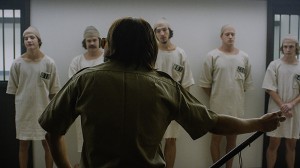We live in a world of broad-based entertainment as the films released in each of our favorite genres are often engineered to have the widest possible appeal. There’s nothing wrong with that. It’s healthy. Audiences not only want to be entertained – they need to be. While there is often great artistry in such endeavors – they certainly aren’t always art. It takes a different kind of film to be considered as such.
While many can debate as to what makes a film, artistic – one underlying question remains constant – did the work move its audience? Because if it fails to engage the audience, how could it be art, when it’s barely existing as entertainment?
The flip side of this is how audiences interpret films that shock them or expand their world view. We don’t see films like this too often, as they don’t inherently have the broadest of appeal, but we should never forget that It is imperative for the art of cinema not only to entertain, but also to shock, disgust and without a doubt get a rise out of its audience.
The Stanford Prison Experiment succeeds beautifully in doing this. It moves its audience into a shellshocked realm as the filmmakers have delivered a visceral human experience by painstakingly recreating a disturbing psychological experiment that happened over 40 years ago—but seems as relevant as if it just happened yesterday.
Firing on all cylinders to shock, inform and move its audience—The Stanford Prison Experiment easily presents itself as a top contender for both a directing award and Waldo Salt Award for Screenwriting.
Tim Talbott’s script is a success because he simply throws the viewer into the experiment in the same way in which the students at Stanford were tossed to the lions.
There’s a ticking clock at hand, as the experiment is scheduled to last 14 days. Amusingly after seeing how crazy things go on day one, it makes the audience wonder just how much longer these students can possibly continue.
Talbott chose to make the film a true ensemble piece which is one of its many saving graces because for such a complex experience it would have been a waste of time to simply stick with one subject, or observer. Talbott instead takes an omniscient point of view that benefits the audience by truly gauging the scope of just how intense the situation became and how it personally challenged all the individuals involved in it.
The danger of ensemble writing is that there’s often not enough time to make anyone three dimensional enough for the audience to care, but the beauty of the setup here is that beyond the observers all the test subjects were strangers and only gained insight into each other’s lives as their time together continued. It makes for a leveled playing field and adds to the intrigue of the tale.
Director Kyle Patrick Alvarez does a phenomenal job handling the complex duties at hand. For starters the true claustrophobia of the converted Stanford lab basement into a small prison worked excellently and we quickly not only got a sense of where we are, but how trapped all of the subjects and at times even observers must have felt. The performances were excellent, as both the director and his cast truly dug their heels into the experience.
As for what that experience is – let’s take a brief moment in case you’re unfamiliar, to catch you up with a synopsis. I wouldn’t dare write out a synopsis when I have such a great one from the Sundance Guide – the review continues after: “It is the summer of 1971. Dr. Philip Zimbardo launches a study on the psychology of imprisonment. Twenty-four male undergraduates are randomly assigned to be either a guard or a prisoner. Set in a simulated jail, the project unfolds. The participants rapidly embody their roles—the guards become power-hungry and sadistic, while the prisoners, subject to degradation, strategize as underdogs. It soon becomes clear that, as Zimbardo and team monitor the escalation of action through surveillance cameras, they are not fully aware of how they, too, have become part of the experiment.
Based on the real-life research of Dr. Zimbardo (who was a consultant on the film), The Stanford Prison Experiment is a dramatic period piece that remains relevant over 40 years later. Along with an impressive cast, including Billy Crudup as Zimbardo, Kyle Patrick Alvarez (C.O.G., 2013 Sundance Film Festival) delivers an intense, visceral film about the role of power that plays to both chilling and exhilarating effect. —K.Y – 2015 Sundance Guide.”
For something so well constructed, its only problem is ultimately its subject matter. Talbott, Alvarez and their cast do their jobs so well that at times the film is difficult to watch as its lessons show such an ugly truism of human nature that to view it is at times both difficult and harrowing. Yet, you can’t stop watching it and that is exactly why The Stanford Prison Experiment is an important film. Its prescient lessons are just as relevant today as they were 40 years ago and until the human race decides to better learn them, we’re destined to continue to drag each other down.
As of press time the film had not been bought, but when a distributor finally is bold enough to step in and snatch it up, I can only hope audiences show up in droves so that more such challenging films will get made..
The Stanford Prison Experiment
Director: Kyle Patrick Alvarez
Screenwriter: Tim Talbott
